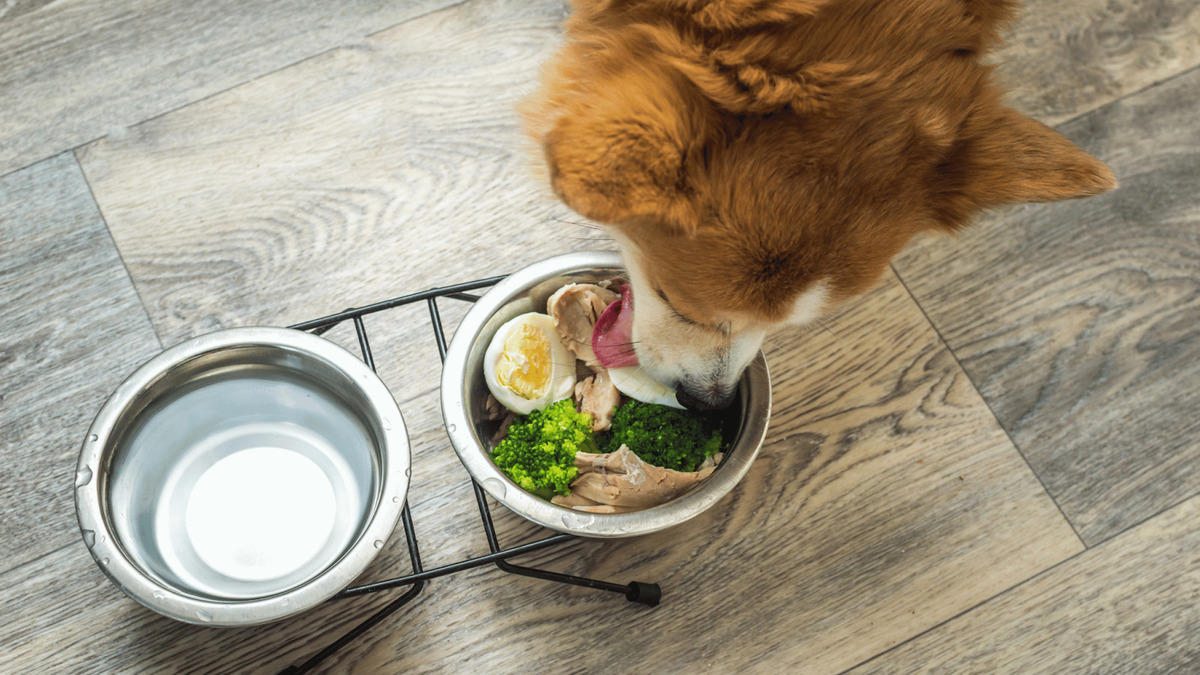Home>Health & Wellness>Nutrition & Diet>What Is A BARF Diet For Dogs


Nutrition & Diet
What Is A BARF Diet For Dogs
Published: January 28, 2024
Discover the benefits of a BARF diet for dogs and learn how proper nutrition and diet can improve your pet's health and well-being. Explore the key components of a balanced diet for your canine companion.
(Many of the links in this article redirect to a specific reviewed product. Your purchase of these products through affiliate links helps to generate commission for Pawsomeoldies.com, at no extra cost. Learn more)
Table of Contents
Introduction
The BARF diet, which stands for Biologically Appropriate Raw Food or Bones and Raw Food, is a diet for dogs that aims to replicate the natural, ancestral diet of wild canines. This diet consists of raw, unprocessed foods such as muscle meat, bones, organs, fruits, and vegetables. Proponents of the BARF diet believe that it provides numerous health benefits for dogs by closely mimicking the diet that their ancestors consumed in the wild.
The concept of the BARF diet is rooted in the belief that dogs are biologically designed to thrive on a diet that closely resembles what their wild ancestors consumed. Advocates of this diet argue that commercial dog foods, which are often processed and contain artificial additives, may not provide the optimal nutrition that dogs need to thrive. Instead, they propose that a diet consisting of raw, natural ingredients can better support a dog's overall health and well-being.
As pet owners increasingly seek natural and holistic approaches to pet care, the BARF diet has gained popularity as a way to provide dogs with a diet that aligns with their evolutionary history. By feeding dogs a variety of raw foods, supporters of the BARF diet aim to promote better digestion, improved dental health, a shinier coat, increased energy levels, and a stronger immune system.
In the following sections, we will delve deeper into the specifics of the BARF diet, exploring its components, benefits, potential risks, and considerations. Additionally, we will provide guidance on how to transition a dog to a BARF diet effectively. Whether you are considering transitioning your dog to a BARF diet or simply seeking to learn more about this approach, this comprehensive guide will equip you with the knowledge needed to make informed decisions about your dog's nutrition.
Read more: What Liquid Diet Is For Dogs
What is a BARF diet?
The BARF diet, an acronym for Biologically Appropriate Raw Food or Bones and Raw Food, is a canine diet regimen that prioritizes raw, unprocessed foods to emulate the natural diet of wild canines. This diet typically includes a combination of raw muscle meat, bones, organs, fruits, and vegetables. The fundamental principle behind the BARF diet is to provide dogs with a diet that closely resembles what their ancestors consumed in the wild.
Advocates of the BARF diet argue that it offers a range of benefits for dogs by aligning with their biological and evolutionary needs. They believe that the natural, unprocessed nature of the diet can contribute to improved overall health and well-being for dogs. By incorporating raw, natural ingredients, the BARF diet aims to provide dogs with essential nutrients while minimizing the consumption of artificial additives and processed ingredients commonly found in commercial dog foods.
The BARF diet is rooted in the belief that dogs are biologically designed to thrive on a diet that closely resembles what their wild ancestors consumed. Proponents of this diet emphasize the importance of providing dogs with a diverse range of raw foods, including raw meaty bones, muscle meat, organ meats, fruits, and vegetables. This variety is thought to offer a balanced nutritional profile that supports a dog's overall health and vitality.
It's important to note that the BARF diet is not a one-size-fits-all approach, and the specific composition of the diet can vary based on factors such as a dog's age, size, activity level, and individual dietary needs. Additionally, proponents of the BARF diet often emphasize the significance of sourcing high-quality, human-grade ingredients to ensure the safety and nutritional adequacy of the diet.
In summary, the BARF diet represents a natural and holistic approach to canine nutrition, aiming to provide dogs with a diet that aligns with their evolutionary history. By prioritizing raw, unprocessed foods, the BARF diet seeks to offer dogs a nutritionally rich diet that supports their overall health and well-being.
Benefits of a BARF diet for dogs
The BARF diet offers a myriad of potential benefits for dogs, stemming from its emphasis on raw, unprocessed foods that align with their biological and evolutionary needs. Proponents of the BARF diet advocate for its ability to promote overall health and well-being in dogs through the following key advantages:
-
Improved Digestive Health: The raw, natural components of the BARF diet, including raw meaty bones and organ meats, are believed to support healthy digestion in dogs. Proponents argue that these raw foods contain essential enzymes and nutrients that can aid in digestion and contribute to optimal gastrointestinal function.
-
Enhanced Dental Health: Chewing on raw meaty bones, a staple of the BARF diet, is thought to promote dental health in dogs. The act of gnawing on bones can help reduce plaque and tartar buildup, leading to improved oral hygiene and potentially reducing the risk of dental issues such as periodontal disease.
-
Optimized Nutritional Intake: The BARF diet emphasizes a diverse range of raw foods, including muscle meat, organs, fruits, and vegetables, to provide dogs with a balanced nutritional profile. Proponents argue that this variety can offer a wide array of essential nutrients, including vitamins, minerals, and amino acids, which are vital for supporting overall health and vitality.
-
Healthy Skin and Coat: Advocates of the BARF diet often highlight the potential for improved skin and coat health in dogs. The diet's focus on raw, natural ingredients is believed to contribute to healthier skin, reduced itching, and a shinier, lustrous coat, potentially enhancing a dog's overall appearance and comfort.
-
Boosted Immune System: Proponents of the BARF diet suggest that the natural, nutrient-dense components of the diet can support a dog's immune system. By providing essential nutrients and minimizing the intake of artificial additives, the diet aims to bolster a dog's natural defenses, potentially reducing the risk of certain health issues.
-
Increased Energy and Vitality: Some supporters of the BARF diet report observing increased energy levels and vitality in dogs following the transition to this diet. They attribute this to the high-quality, natural ingredients that the diet prioritizes, which may contribute to improved overall energy and well-being in dogs.
In summary, the BARF diet is purported to offer a range of potential benefits for dogs, including improved digestive health, enhanced dental hygiene, optimized nutritional intake, healthier skin and coat, a strengthened immune system, and increased energy and vitality. While individual results may vary, many proponents of the BARF diet believe that it can positively impact a dog's overall health and well-being when implemented thoughtfully and responsibly.
Risks and considerations
While the BARF diet offers potential benefits for dogs, it is essential to consider the associated risks and factors that require careful attention. Understanding these considerations can help pet owners make informed decisions about whether the BARF diet is suitable for their canine companions.
Potential Health Risks
One of the primary concerns associated with the BARF diet is the risk of bacterial contamination. Raw meat, bones, and organs can harbor harmful bacteria such as Salmonella and E. coli, posing a potential health hazard to dogs. Additionally, the handling and storage of raw food ingredients require strict adherence to food safety practices to minimize the risk of bacterial contamination.
Nutritional Imbalance
While the BARF diet aims to provide a balanced nutritional profile, achieving this balance can be challenging without careful planning and oversight. Inadequate variety or improper ratios of essential nutrients in the diet can lead to nutritional imbalances, potentially impacting a dog's overall health. For example, an excessive intake of certain nutrients or a deficiency in others can result in health issues such as bone abnormalities, organ dysfunction, or compromised immune function.
Dental Hazards
Although chewing on raw meaty bones is often touted as beneficial for dental health, there are inherent risks associated with bone consumption. Dogs may experience dental fractures, gastrointestinal obstructions, or choking hazards when consuming bones, particularly if they are not appropriately sized or supervised during feeding.
Transition Challenges
Transitioning a dog to the BARF diet requires careful consideration and gradual adjustment. Abrupt dietary changes can lead to digestive upset, including vomiting, diarrhea, and gastrointestinal discomfort. It is essential to introduce the new diet gradually, allowing the dog's digestive system to adapt to the raw food components over time.
Individual Sensitivities
Not all dogs may tolerate or thrive on a raw food diet. Some dogs may have underlying health conditions, sensitivities, or allergies that make them unsuitable candidates for the BARF diet. It is crucial to assess a dog's individual health status and consult with a veterinarian before embarking on a dietary transition to ensure that the BARF diet aligns with the dog's specific needs and circumstances.
Read more: What Dog Diet Helps Stop Pancreatitis
Responsible Sourcing
The BARF diet necessitates the sourcing of high-quality, human-grade ingredients to mitigate the risk of foodborne illnesses and ensure the nutritional adequacy of the diet. Pet owners must exercise diligence in selecting reputable suppliers and handling raw food ingredients with care to uphold food safety standards.
In summary, while the BARF diet offers potential benefits for dogs, it is crucial to acknowledge and address the associated risks and considerations. By prioritizing food safety, nutritional balance, dental caution, gradual transitions, individual sensitivities, and responsible sourcing, pet owners can navigate the complexities of the BARF diet and make informed choices that support their dogs' health and well-being.
How to transition your dog to a BARF diet
Transitioning your dog to a BARF diet requires careful planning and a gradual approach to ensure a smooth adjustment to the new dietary regimen. Here are essential steps to consider when transitioning your dog to a BARF diet:
-
Consult with a Veterinarian: Before embarking on the transition, it is crucial to consult with a veterinarian to assess your dog's current health status and nutritional needs. A veterinarian can provide valuable insights and guidance tailored to your dog's individual requirements, ensuring a safe and appropriate transition to the BARF diet.
-
Research and Education: Take the time to educate yourself about the principles of the BARF diet and the specific nutritional requirements of dogs. Understanding the essential components of the diet, including raw meaty bones, muscle meat, organ meats, fruits, and vegetables, will enable you to make informed decisions and create a well-balanced meal plan for your dog.
-
Gradual Introduction: Start by gradually introducing small amounts of raw food into your dog's existing diet. Begin with a small portion of raw meat or bone, gradually increasing the proportion over several days or weeks. This gradual approach allows your dog's digestive system to adapt to the new diet and minimizes the risk of digestive upset.
-
Monitor and Observe: Throughout the transition process, closely monitor your dog's response to the new diet. Look for signs of digestive discomfort, allergic reactions, or any adverse effects. Observing your dog's behavior and overall well-being will help you make necessary adjustments and ensure a positive transition experience.
-
Balanced Nutrition: Focus on providing a balanced nutritional intake as you transition to the BARF diet. Incorporate a variety of raw foods to ensure that your dog receives essential nutrients, including protein, vitamins, minerals, and fatty acids. Aim for a diverse and well-rounded diet to support your dog's overall health and vitality.
-
Food Safety Practices: Adhere to strict food safety practices when handling and storing raw food ingredients. Keep raw meats and bones refrigerated or frozen until they are ready to be served, and sanitize food preparation surfaces and utensils to minimize the risk of bacterial contamination.
-
Supervision and Adjustment: As your dog becomes accustomed to the BARF diet, continue to supervise meal times and assess your dog's response to the new foods. Adjust the diet as needed based on your dog's individual preferences and nutritional requirements, ensuring that the diet remains well-suited to your dog's needs.
By following these steps and approaching the transition with patience and attentiveness, you can effectively introduce your dog to a BARF diet while prioritizing their health and well-being. Remember that every dog is unique, and the transition process may vary based on individual preferences and sensitivities. With careful planning and consideration, the BARF diet can offer a natural and nutritionally rich dietary option for your canine companion.
Conclusion
In conclusion, the BARF diet presents a compelling approach to canine nutrition, aiming to align with the natural dietary needs of dogs and promote their overall health and well-being. By prioritizing raw, unprocessed foods such as raw meaty bones, muscle meat, organs, fruits, and vegetables, the BARF diet seeks to provide dogs with a nutritionally rich and biologically appropriate diet.
Throughout this comprehensive exploration of the BARF diet, we have delved into its fundamental principles, potential benefits, associated risks, and considerations for transitioning dogs to this dietary regimen. The BARF diet offers a range of potential advantages, including improved digestive health, enhanced dental hygiene, optimized nutritional intake, healthier skin and coat, a strengthened immune system, and increased energy and vitality. These benefits stem from the diet's emphasis on raw, natural ingredients that closely align with a dog's evolutionary and biological needs.
However, it is essential to approach the BARF diet with careful consideration and awareness of the associated risks. Factors such as bacterial contamination, nutritional imbalance, dental hazards, transition challenges, individual sensitivities, and responsible sourcing require thoughtful attention to ensure the safety and well-being of dogs transitioning to this diet.
When embarking on the transition to a BARF diet, pet owners are encouraged to consult with a veterinarian, conduct thorough research, gradually introduce raw foods, monitor their dog's response, prioritize balanced nutrition, adhere to food safety practices, and supervise the transition process closely. By approaching the transition with diligence and attentiveness, pet owners can navigate the complexities of the BARF diet and make informed decisions that support their dogs' health and vitality.
Ultimately, the decision to transition a dog to a BARF diet should be guided by a thorough understanding of the diet's principles, the specific needs of the individual dog, and a commitment to responsible pet care. While the BARF diet offers a natural and holistic approach to canine nutrition, it is important to weigh its potential benefits against the associated considerations and make choices that align with the well-being of the beloved canine companions.
In essence, the BARF diet represents a conscientious effort to provide dogs with a diet that honors their biological heritage and aims to optimize their health and vitality through the consumption of raw, natural foods. Whether pet owners choose to embrace the BARF diet or explore alternative dietary approaches, the well-being and welfare of dogs remain at the heart of the decision-making process, reflecting the deep bond and commitment shared between humans and their loyal canine companions.













